3D Reconstruction of Non-Rigid Plants and Sensor Data Fusion for Agriculture Phenotyping
Abstract
1. Introduction
2. Related Works
2.1. Robotics in Agriculture
2.2. 3D Plants Reconstruction
3. Proposed System: Materials and Methods
3.1. Robotic System for Terrestrial Data Acquisition
3.2. Non-Rigid 3D Plant Reconstruction System
3.2.1. Background Removal
3.2.2. Point Cloud Standardization
3.2.3. Outliers Removal
3.2.4. Point Cloud Smoothing
3.2.5. Advancing Front Surface Reconstruction
3.2.6. Keypoints Definition, Description and Correspondence
3.2.7. Model Deformation
3.2.8. Input and Model Surfaces Fusion
3.2.9. Model and Sensors Data Fusion
4. Results
5. Discussion
6. Conclusions
Author Contributions
Funding
Acknowledgments
Conflicts of Interest
Abbreviations
| 3D | Three-dimensional |
| ARAP | As-Rigid-As-Possible |
| CGAL | Computational Geometry Algorithms Library |
| CPD | Coherent Point Drift |
| CPU | Central Process Unit |
| GPS | Global Positioning System |
| GPU | Graphics Processing Unit |
| ICP | Iterative Closest Point |
| Inter-Integrated Circuit | |
| IMU | Inertial Measurement Unit |
| LiDAR | Light Detection Furthermore, Ranging |
| LOP | Locally Optimal Projector |
| NRMSE | Normalized Root Mean Square Error |
| NURBS | Non-uniform Rational B-Spline |
| PCA | Principal Component Analysis |
| PCL | Point Cloud Library |
| PLY | Polygon File Format |
| RGB | Red, Green and Blue |
| RGB-D | Red, Green, Blue and Depth |
| RMSE | Root Mean Square Error |
| ROS | Robot Operating System |
| SDF | Signed Distance Function |
| SHOT | Signature of Histograms of Orientations |
| SLAM | Simultaneous Localization and Mapping |
| SR-ARAP | Smoothed Rotation Enhanced As-Rigid-As Possible |
| TSDF | Truncated Signed Distance Function |
| USB | Universal Serial Bus |
| UTP | Unshielded Twisted Pair |
References
- FAOSTAT. Food and Agriculture Data from Food and Agriculture Organization of the United Nations. 2020. Available online: http://www.fao.org/faostat/en/#data (accessed on 27 January 2021).
- Shafiekhani, A.; Kadam, S.; Fritschi, F.; DeSouza, G. Vinobot and Vinoculer: Two Robotic Platforms for High-Throughput Field Phenotyping. Sensors 2017, 17, 214. [Google Scholar] [CrossRef]
- Kumar, P.; Connor, J.; Mikiavcic, S. High-throughput 3D reconstruction of plant shoots for phenotyping. In Proceedings of the 2014 13th International Conference on Control Automation Robotics & Vision (ICARCV), Marina Bay Sands, Singapore, 10–12 December 2014. [Google Scholar] [CrossRef]
- Paulus, S.; Schumann, H.; Kuhlmann, H.; Léon, J. High-precision laser scanning system for capturing 3D plant architecture and analysing growth of cereal plants. Biosyst. Eng. 2014, 121, 1–11. [Google Scholar] [CrossRef]
- Schwambach, C.; Sobrinho, G.C. Biologia [Livro Eletrônico]; Coleção EJA: Cidadania Competente, v. 7; InterSaberes: Curitiba, Brazil, 2017; Chapter 7. [Google Scholar]
- Zhu, F.; Thapa, S.; Gao, T.; Ge, Y.; Walia, H.; Yu, H. 3D Reconstruction of Plant Leaves for High-Throughput Phenotyping. In Proceedings of the 2018 IEEE International Conference on Big Data (Big Data), Seattle, WA, USA, 10–13 December 2018. [Google Scholar] [CrossRef]
- Chaudhury, A.; Ward, C.; Talasaz, A.; Ivanov, A.G.; Brophy, M.; Grodzinski, B.; Huner, N.P.A.; Patel, R.V.; Barron, J.L. Machine Vision System for 3D Plant Phenotyping. IEEE/ACM Trans. Comput. Biol. Bioinform. 2019, 16, 2009–2022. [Google Scholar] [CrossRef]
- Potena, C.; Khanna, R.; Nieto, J.; Siegwart, R.; Nardi, D.; Pretto, A. AgriColMap: Aerial-Ground Collaborative 3D Mapping for Precision Farming. IEEE Robot. Autom. Lett. 2019, 4, 1085–1092. [Google Scholar] [CrossRef]
- Weiss, U.; Biber, P. Plant detection and mapping for agricultural robots using a 3D LIDAR sensor. Robot. Auton. Syst. 2011, 59, 265–273. [Google Scholar] [CrossRef]
- Mazoyer, M.; Roudart, L. História das Agriculturas no Mundo: Do Neolítico à Crise Contemporânea; UNESP-NEAD: São Paulo, Brazil, 2009; Chapters 1, 2, 9 and 10. [Google Scholar]
- de Freitas Vian, C.E.; Júnior, A.M.A.; Baricelo, L.G.; da Silva, R.P. Origens, evolução e tendências da indústria de máquinas agrícolas. Rev. Econ. Sociol. Rural. 2013, 51, 719–744. [Google Scholar] [CrossRef][Green Version]
- Massruhá, S.M.F.S.; de Andrade Leite, M.A.; Junior, A.L.; Romani, L.A.S. Tecnologias da Informação e Comunicação e suas Relações com a Agricultura; Embrapa: Brasilia, Brazil, 2014; Chapter 1. [Google Scholar]
- Duckett, T.; Pearson, S.; Blackmore, S.; Grieve, B.; Chen, W.H.; Cielniak, G.; Cleaversmith, J.; Dai, J.; Davis, S.; Fox, C.; et al. Agricultural Robotics: The Future of Robotic Agriculture. UK-RAS Network White Papers; UK Robotics and Autonomous Systems: London, UK, 2018. [Google Scholar]
- CASE IH. Automation. 2020. Available online: https://www.caseih.com/northamerica/en-us/innovations/automation (accessed on 16 August 2020).
- Agrointelli. Robotti. 2020. Available online: https://www.agrointelli.com/robotti (accessed on 16 August 2020).
- Haibo, L.; Shuliang, D.; Zunmin, L.; Chuijie, Y. Study and Experiment on a Wheat Precision Seeding Robot. J. Robot. 2015, 2015, 1–9. [Google Scholar] [CrossRef]
- Srinivasan, N.; Prabhu, P.; Smruthi, S.S.; Sivaraman, N.V.; Gladwin, S.J.; Rajavel, R.; Natarajan, A.R. Design of an autonomous seed planting robot. In Proceedings of the 2016 IEEE Region 10 Humanitarian Technology Conference (R10-HTC), Agra, India, 21–23 December 2016. [Google Scholar] [CrossRef]
- Fendt. Fendt Puts the New Robot ’Xaver’ to Use. 2017. Available online: https://www.fendt.com/int/fendt-xaver (accessed on 16 August 2020).
- RISE ABOVE. Home Page. 2020. Available online: https://www.riseabove.com.au (accessed on 17 August 2020).
- Ristorto, G.; Gallo, R.; Gasparetto, A.; Scalera, L.; Vidoni, R.; Mazzetto, F. A mobile laboratory for orchard health status monitoring in precision farming. Chem. Eng. Trans. 2017, 58, 661–666. [Google Scholar] [CrossRef]
- Mueller-Sim, T.; Jenkins, M.; Abel, J.; Kantor, G. The Robotanist: A ground-based agricultural robot for high-throughput crop phenotyping. In Proceedings of the 2017 IEEE International Conference on Robotics and Automation (ICRA), Marina Bay Sands, Singapore, 29 May–3 June 2017. [Google Scholar] [CrossRef]
- Bao, Y.; Tang, L.; Srinivasan, S.; Schnable, P.S. Field-based architectural traits characterisation of maize plant using time-of-flight 3D imaging. Biosyst. Eng. 2019, 178, 86–101. [Google Scholar] [CrossRef]
- Chapman, S.; Merz, T.; Chan, A.; Jackway, P.; Hrabar, S.; Dreccer, M.; Holland, E.; Zheng, B.; Ling, T.; Jimenez-Berni, J. Pheno-Copter: A Low-Altitude, Autonomous Remote-Sensing Robotic Helicopter for High-Throughput Field-Based Phenotyping. Agronomy 2014, 4, 279–301. [Google Scholar] [CrossRef]
- Cantelli, L.; Bonaccorso, F.; Longo, D.; Melita, C.D.; Schillaci, G.; Muscato, G. A Small Versatile Electrical Robot for Autonomous Spraying in Agriculture. AgriEngineering 2019, 1, 391–402. [Google Scholar] [CrossRef]
- NAIO TECHNOLOGIES. DINO Autonomous Vegetable Weeding Robot—DINO. 2020. Available online: https://www.naio-technologies.com/en/agricultural-equipment/large-scale-vegetable-weeding-robot (accessed on 17 August 2020).
- Ecorobotix. Technology for Environment. 2020. Available online: https://www.ecorobotix.com/en (accessed on 17 August 2020).
- DJI. A DJI Agriculture. 2020. Available online: https://ag.dji.com/pt-br (accessed on 20 August 2020).
- BLUE RIVER TECHNOLOGY. Our See and Spray Machines. 2020. Available online: http://smartmachines.bluerivertechnology.com (accessed on 16 August 2020).
- Silwal, A.; Davidson, J.R.; Karkee, M.; Mo, C.; Zhang, Q.; Lewis, K. Design, integration, and field evaluation of a robotic apple harvester. J. Field Robot. 2017, 34, 1140–1159. [Google Scholar] [CrossRef]
- Agrobot. Agricultural Robots. 2020. Available online: https://www.agrobot.com (accessed on 17 August 2020).
- Abundant Robotics. Home Page. 2020. Available online: https://www.abundantrobotics.com (accessed on 16 August 2020).
- Energid. Citrus Harvesting. 2020. Available online: https://www.energid.com/industries/agricultural-robotics (accessed on 17 August 2020).
- Oliveira, L.F.P.; Moreira, A.P.; Silva, M.F. Advances in Agriculture Robotics: A State-of-the-Art Review and Challenges Ahead. Robotics 2021, 10, 52. [Google Scholar] [CrossRef]
- Sung, C.; Kim, P.Y. 3D terrain reconstruction of construction sites using a stereo camera. Autom. Constr. 2016, 64, 65–77. [Google Scholar] [CrossRef]
- Wu, Q.; Yang, H.; Wei, M.; Remil, O.; Wang, B.; Wang, J. Automatic 3D reconstruction of electrical substation scene from LiDAR point cloud. ISPRS J. Photogramm. Remote Sens. 2018, 143, 57–71. [Google Scholar] [CrossRef]
- Jing, N.B.; Ma, X.M.; Guo, W. 3D Reconstruction of Underground Tunnel Using Kinect Camera. In Proceedings of the 2018 International Symposium on Computer, Consumer and Control (IS3C), Taichung, Taiwan, 6–8 December 2018. [Google Scholar] [CrossRef]
- Cheng, L.; Tong, L.; Chen, Y.; Zhang, W.; Shan, J.; Liu, Y.; Li, M. Integration of LiDAR data and optical multi-view images for 3D reconstruction of building roofs. Opt. Lasers Eng. 2013, 51, 493–502. [Google Scholar] [CrossRef]
- Hu, Y.; Chen, Y.; Wu, Z. Unmanned Aerial Vehicle and Ground Remote Sensing Applied in 3D Reconstruction of Historical Building Groups in Ancient Villages. In Proceedings of the 2018 Fifth International Workshop on Earth Observation and Remote Sensing Applications (EORSA), Xi’an, China, 18–20 June 2018. [Google Scholar] [CrossRef]
- Lacher, R.; Vasconcelos, F.; Williams, N.; Rindermann, G.; Hipwell, J.; Hawkes, D.; Stoyanov, D. Nonrigid reconstruction of 3D breast surfaces with a low-cost RGBD camera for surgical planning and aesthetic evaluation. Med Image Anal. 2019, 53, 11–25. [Google Scholar] [CrossRef] [PubMed]
- Zollhöfer, M.; Stotko, P.; Görlitz, A.; Theobalt, C.; Nießner, M.; Klein, R.; Kolb, A. State of the Art on 3D Reconstruction with RGB-D Cameras. Comput. Graph. Forum 2018, 37, 625–652. [Google Scholar] [CrossRef]
- Besl, P.; McKay, N.D. A method for registration of 3-D shapes. IEEE Trans. Pattern Anal. Mach. Intell. 1992, 14, 239–256. [Google Scholar] [CrossRef]
- Mora, H.; Mora-Pascual, J.M.; García-García, A.; Martínez-González, P. Computational Analysis of Distance Operators for the Iterative Closest Point Algorithm. PLoS ONE 2016, 11, e0164694. [Google Scholar] [CrossRef]
- Henry, P.; Krainin, M.; Herbst, E.; Ren, X.; Fox, D. RGB-D mapping: Using Kinect-style depth cameras for dense 3D modeling of indoor environments. Int. J. Robot. Res. 2012, 31, 647–663. [Google Scholar] [CrossRef]
- Huang, X.; Hu, M. 3D Reconstruction Based on Model Registration Using RANSAC-ICP Algorithm. In Transactions on Edutainment XI; Springer: Berlin/Heidelberg, Germany, 2015; Volume 8971, pp. 46–51. [Google Scholar] [CrossRef]
- Newcombe, R.A.; Fitzgibbon, A.; Izadi, S.; Hilliges, O.; Molyneaux, D.; Kim, D.; Davison, A.J.; Kohi, P.; Shotton, J.; Hodges, S. KinectFusion: Real-time dense surface mapping and tracking. In Proceedings of the 2011 10th IEEE International Symposium on Mixed and Augmented Reality, Basel, Switzerland, 26–29 October 2011. [Google Scholar] [CrossRef]
- Newcombe, R.A.; Fox, D.; Seitz, S.M. DynamicFusion: Reconstruction and tracking of non-rigid scenes in real-time. In Proceedings of the 2015 IEEE Conference on Computer Vision and Pattern Recognition (CVPR), Boston, MA, USA, 7–12 June 2015. [Google Scholar] [CrossRef]
- Innmann, M.; Zollhöfer, M.; Nießner, M.; Theobalt, C.; Stamminger, M. VolumeDeform: Real-Time Volumetric Non-rigid Reconstruction. In Computer Vision – ECCV 2016; Springer: Berlin/Heidelberg, Germany, 2016; Volume 9912, pp. 362–379. [Google Scholar] [CrossRef]
- Dou, M.; Khamis, S.; Degtyarev, Y.; Davidson, P.; Fanello, S.R.; Kowdle, A.; Escolano, S.O.; Rhemann, C.; Kim, D.; Taylor, J.; et al. Fusion4D. ACM Trans. Graph. 2016, 35, 1–13. [Google Scholar] [CrossRef]
- Dou, M.; Davidson, P.; Fanello, S.R.; Khamis, S.; Kowdle, A.; Rhemann, C.; Tankovich, V.; Izadi, S. Motion2fusion. ACM Trans. Graph. 2017, 36, 1–16. [Google Scholar] [CrossRef]
- Slavcheva, M.; Baust, M.; Cremers, D.; Ilic, S. KillingFusion: Non-rigid 3D Reconstruction without Correspondences. In Proceedings of the 2017 IEEE Conference on Computer Vision and Pattern Recognition (CVPR), Honolulu, HI, USA, 21–26 July 2017. [Google Scholar] [CrossRef]
- Guo, K.; Xu, F.; Yu, T.; Liu, X.; Dai, Q.; Liu, Y. Real-Time Geometry, Albedo, and Motion Reconstruction Using a Single RGB-D Camera. ACM Trans. Graph. 2017, 36, 1–13. [Google Scholar] [CrossRef]
- Slavcheva, M.; Baust, M.; Ilic, S. SobolevFusion: 3D Reconstruction of Scenes Undergoing Free Non-rigid Motion. In Proceedings of the 2018 IEEE/CVF Conference on Computer Vision and Pattern Recognition, Salt Lake City, UT, USA, 18–23 June 2018. [Google Scholar] [CrossRef]
- Chaivivatrakul, S.; Tang, L.; Dailey, M.N.; Nakarmi, A.D. Automatic morphological trait characterization for corn plants via 3D holographic reconstruction. Comput. Electron. Agric. 2014, 109, 109–123. [Google Scholar] [CrossRef]
- Gibbs, J.A.; Pound, M.; French, A.; Wells, D.; Murchie, E.; Pridmore, T. Active Vision and Surface Reconstruction for 3D Plant Shoot Modelling. IEEE/ACM Trans. Comput. Biol. Bioinform. 2019. [Google Scholar] [CrossRef]
- Gelard, W.; Devy, M.; Herbulot, A.; Burger, P. Model-based Segmentation of 3D Point Clouds for Phenotyping Sunflower Plants. In Proceedings of the 12th International Joint Conference on Computer Vision, Imaging and Computer Graphics Theory and Applications, Porto, Portugal, 27 February–1 March 2017. [Google Scholar] [CrossRef]
- Virlet, N.; Sabermanesh, K.; Sadeghi-Tehran, P.; Hawkesford, M.J. Field Scanalyzer: An automated robotic field phenotyping platform for detailed crop monitoring. Funct. Plant Biol. 2017, 44, 143. [Google Scholar] [CrossRef] [PubMed]
- ROS. Documentation. 2020. Available online: http://wiki.ros.org (accessed on 19 September 2020).
- Clearpath Robotics. Intro to ROS. 2015. Available online: http://www.clearpathrobotics.com/assets/guides/kinetic/ros/Intro%20to%20the%20Robot%20Operating%20System.html (accessed on 20 September 2020).
- Clearpath Robotics. Jackal Unmanned Ground Vehicle. 2020. Available online: https://clearpathrobotics.com/jackal-small-unmanned-ground-vehicle/ (accessed on 20 September 2020).
- Intel Corporation. Intel® RealSenseTM Product Family D400 Series; Intel Corporation: Santa Clara, CA, USA, 2020. [Google Scholar]
- Intel Corporation.Intel RealSense Depth Camera D435i. 2020. Available online: https://www.intelrealsense.com/depth-camera-d435i (accessed on 1 April 2020).
- Texas Instruments. HDC1080 Low Power, High Accuracy Digital Humidity Sensor with Temperature Sensor; Texas Instruments Incorporated: Dallas, TX, USA, January 2016. [Google Scholar]
- Rohm Semiconductor. Digital 16bit Serial Output Type Ambient Light Sensor IC; ROHM Semiconductor: Santa Clara, CA, USA, 2010. [Google Scholar]
- Arduino. Arduino Mega 2560 Rev3. 2021. Available online: https://store.arduino.cc/usa/mega-2560-r3 (accessed on 30 March 2021).
- Intel Corporation. Intel RealSense SDK 2.0. 2020. Available online: https://github.com/IntelRealSense/librealsense (accessed on 22 September 2020).
- Rusu, R.B.; Cousins, S. 3D is here: Point Cloud Library (PCL). In Proceedings of the 2011 IEEE International Conference on Robotics and Automation (ICRA), Shanghai, China, 9–13 May 2011. [Google Scholar] [CrossRef]
- The CGAL Project. CGAL User and Reference Manual. CGAL Editorial Board, 5.1 edition. 2020. Available online: https://doc.cgal.org/latest/Manual/how_to_cite_cgal.html (accessed on 29 April 2021).
- Miller, S. CPU TSDF. 2020. Available online: https://github.com/sdmiller/cpu_tsdf (accessed on 22 September 2020).
- Turk, G. The PLY Polygon File Format. 1994. Available online: https://web.archive.org/web/20161204152348/http://www.dcs.ed.ac.uk/teaching/cs4/www/graphics/Web/ply.html (accessed on 11 June 2021).
- Alliez, P.; Giraudot, S.; Jamin, C.; Lafarge, F.; Mérigot, Q.; Meyron, J.; Saboret, L.; Salman, N.; Wu, S.; Yildiran, N.F. Point Set Processing. In CGAL User and Reference Manual; CGAL 5.1. 2020. Available online: https://doc.cgal.org/latest/Point_set_processing_3/index.html (accessed on 29 April 2021).
- Huang, H.; Wu, S.; Gong, M.; Cohen-Or, D.; Ascher, U.; Zhang, H.R. Edge-aware point set resampling. ACM Trans. Graph. 2013, 32, 1–12. [Google Scholar] [CrossRef]
- Lipman, Y.; Cohen-Or, D.; Levin, D.; Tal-Ezer, H. Parameterization-free projection for geometry reconstruction. In ACM SIGGRAPH 2007 Papers on SIGGRAPH ’07; ACM Press: San Diego, CA, USA, 2007. [Google Scholar] [CrossRef]
- Cohen-Steiner, D.; Da, F. A greedy Delaunay-based surface reconstruction algorithm. Vis. Comput. 2004, 20, 4–16. [Google Scholar] [CrossRef]
- Da, T.K.F.; Cohen-Steiner, D. Advancing Front Surface Reconstruction. In CGAL User and Reference Manual; CGAL 5.1. 2020. Available online: https://doc.cgal.org/latest/Advancing_front_surface_reconstruction/group__PkgAdvancingFrontSurfaceReconstructionRef.html (accessed on 29 April 2021).
- Botsch, M.; Kobbelt, L. A remeshing approach to multiresolution modeling. In Proceedings of the 2004 Eurographics/ACM SIGGRAPH Symposium on Geometry Processing—SGP ’04, Nice, France, 8–10 July 2004. [Google Scholar] [CrossRef]
- Tombari, F.; Salti, S.; Stefano, L.D. Unique Signatures of Histograms for Local Surface Description. In Computer Vision—ECCV 2010; Springer: Berlin/Heidelberg, Germany, 2010; pp. 356–369. [Google Scholar] [CrossRef]
- Levi, Z.; Gotsman, C. Smooth Rotation Enhanced As-Rigid-As-Possible Mesh Animation. IEEE Trans. Vis. Comput. Graph. 2015, 21, 264–277. [Google Scholar] [CrossRef]
- Sorkine, O.; Alexa, M. As-Rigid-As-Possible Surface Modeling. In Proceedings of the Fifth Eurographics Symposium on Geometry Processing (SGP ’07), Barcelona, Spain, 4–6 July 2007; pp. 109–116. [Google Scholar] [CrossRef]
- Loriot, S.; Sorkine-Hornung, O.; Xu, Y.; Yaz, I.O. Triangulated Surface Mesh Deformation. In CGAL User and Reference Manual; CGAL 5.1; 2020. Available online: https://doc.cgal.org/latest/Surface_mesh_deformation/index.html (accessed on 29 April 2021).
- Curless, B.; Levoy, M. A volumetric method for building complex models from range images. In Proceedings of the 23rd Annual Conference on Computer Graphics and Interactive Techniques—SIGGRAPH ’96, New Orleans, LA, USA, 4–9 August 1996. [Google Scholar] [CrossRef]
- Werner, D.; Al-Hamadi, A.; Werner, P. Truncated Signed Distance Function: Experiments on Voxel Size. In Lecture Notes in Computer Science; Springer: Berlin/Heidelberg, Germany, 2014; Volume 8815, pp. 357–364. [Google Scholar] [CrossRef]
- Lorensen, W.E.; Cline, H.E. Marching cubes: A high resolution 3D surface construction algorithm. In Proceedings of the 14th Annual Conference on Computer Graphics and Interactive Techniques—SIGGRAPH ’87, Anaheim, CA, USA, 27–31 July 1987. [Google Scholar] [CrossRef]
- Gautschi, W. Approximation and Interpolation. In Numerical Analysis; Birkhäuser: Boston, MA, USA, 2011; pp. 55–158. [Google Scholar] [CrossRef]
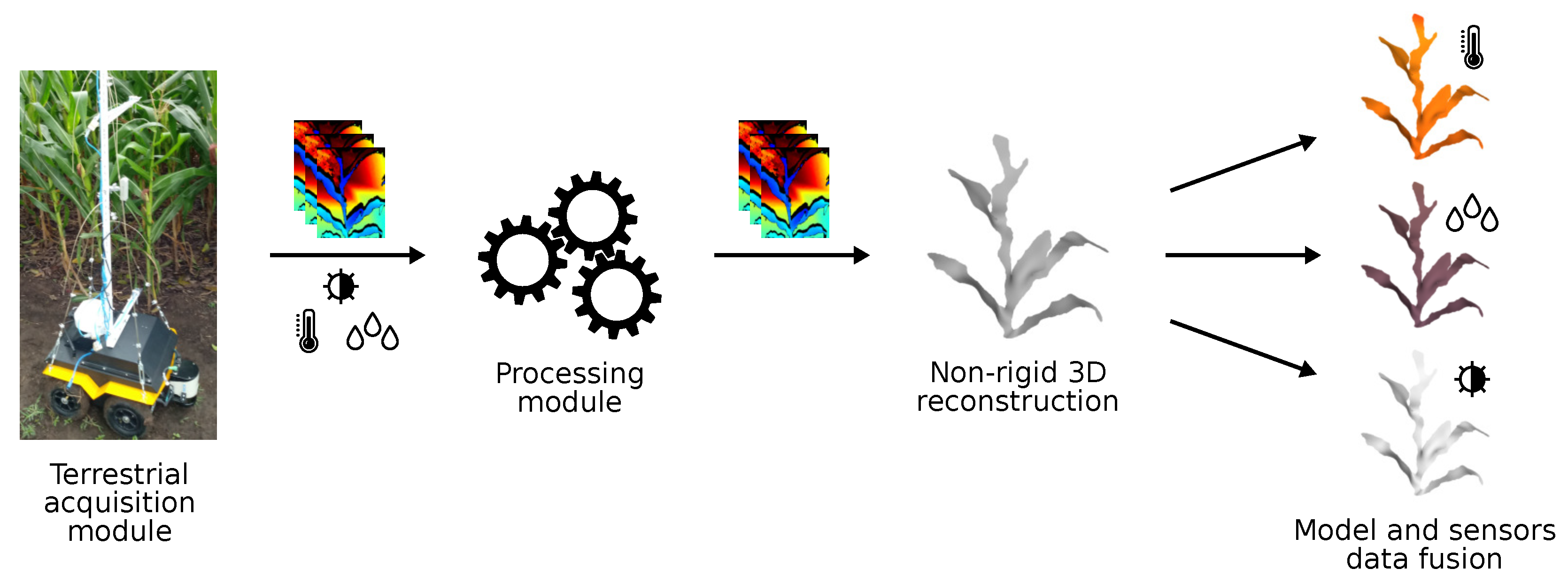

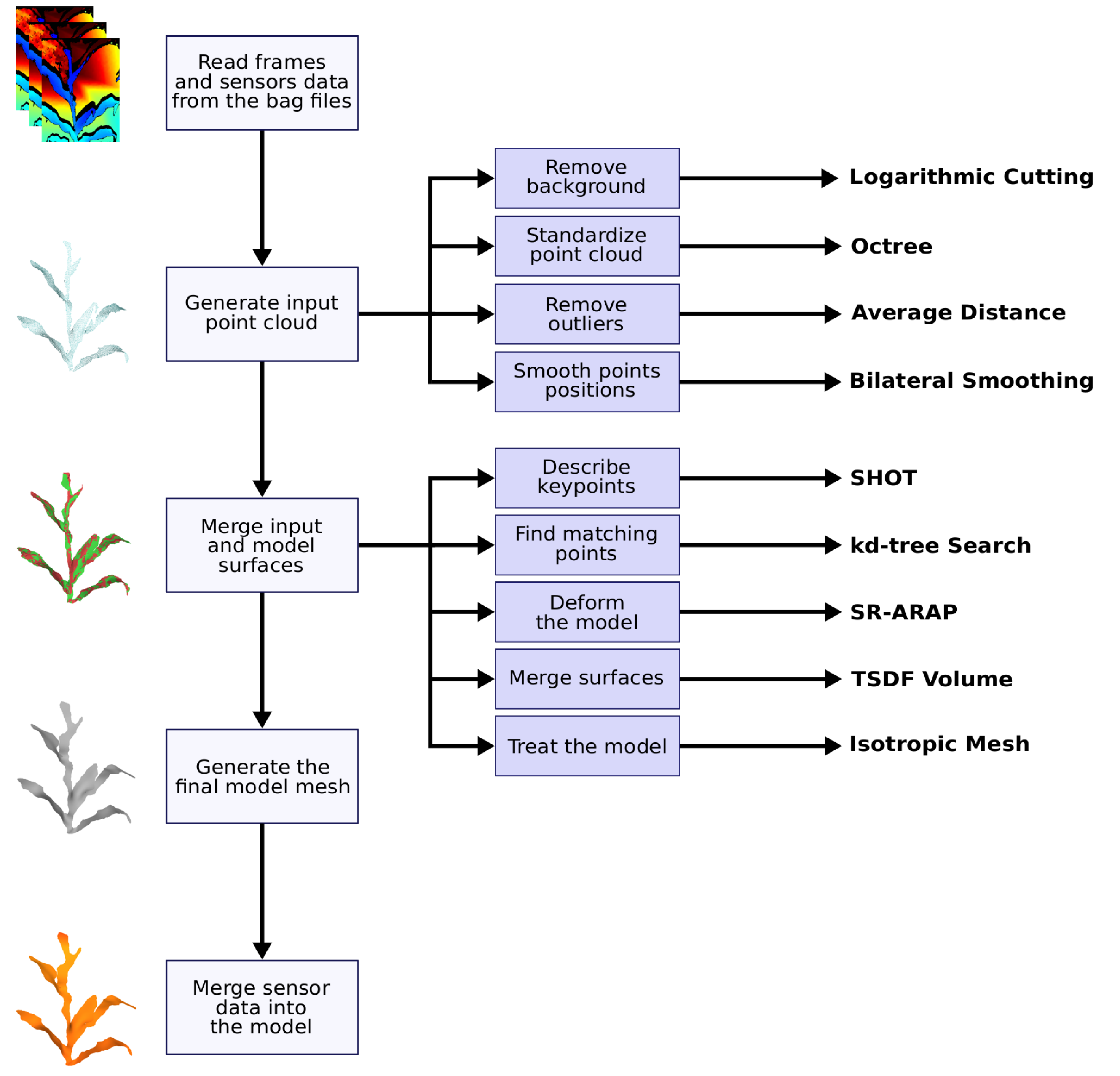


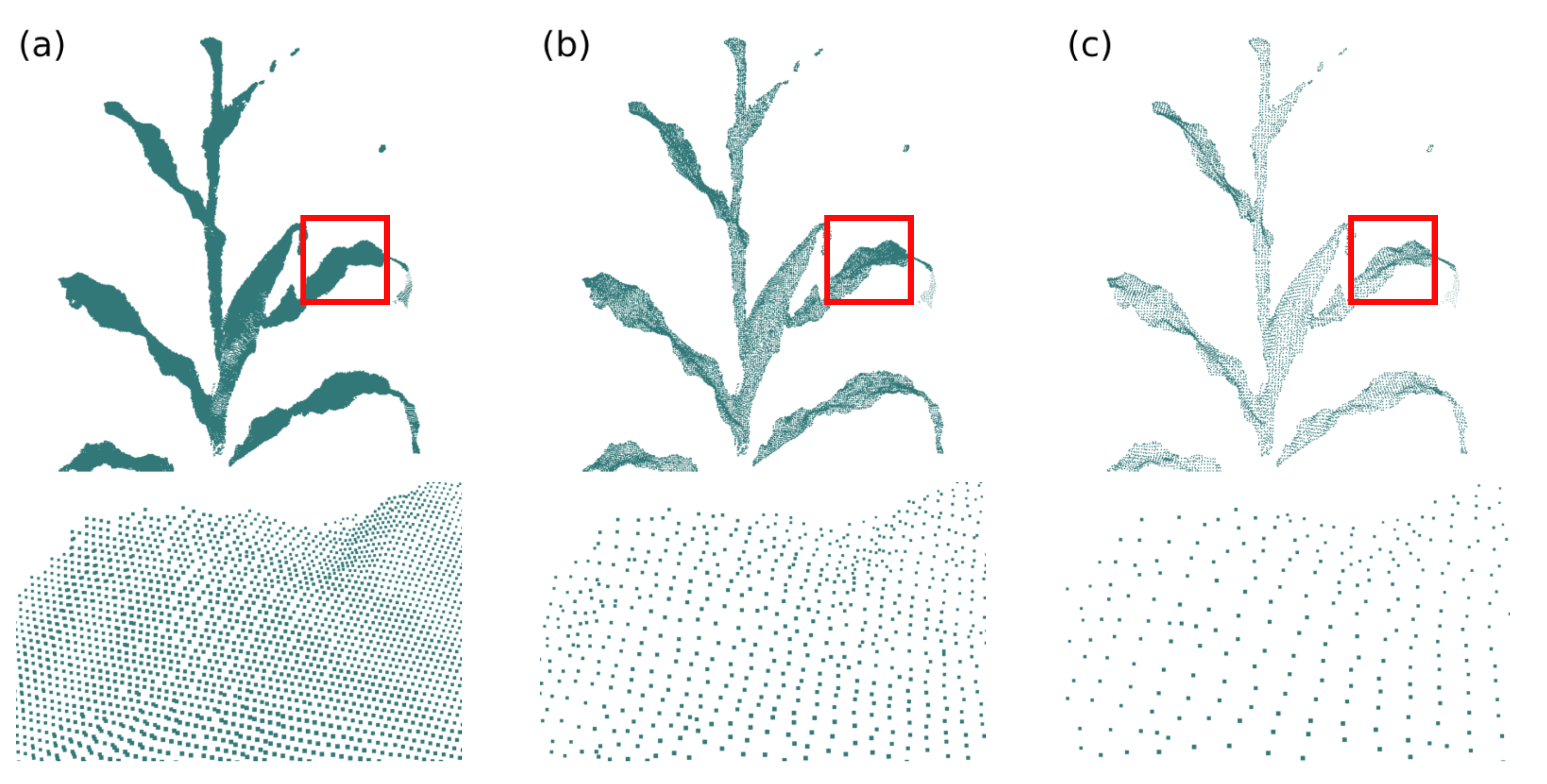
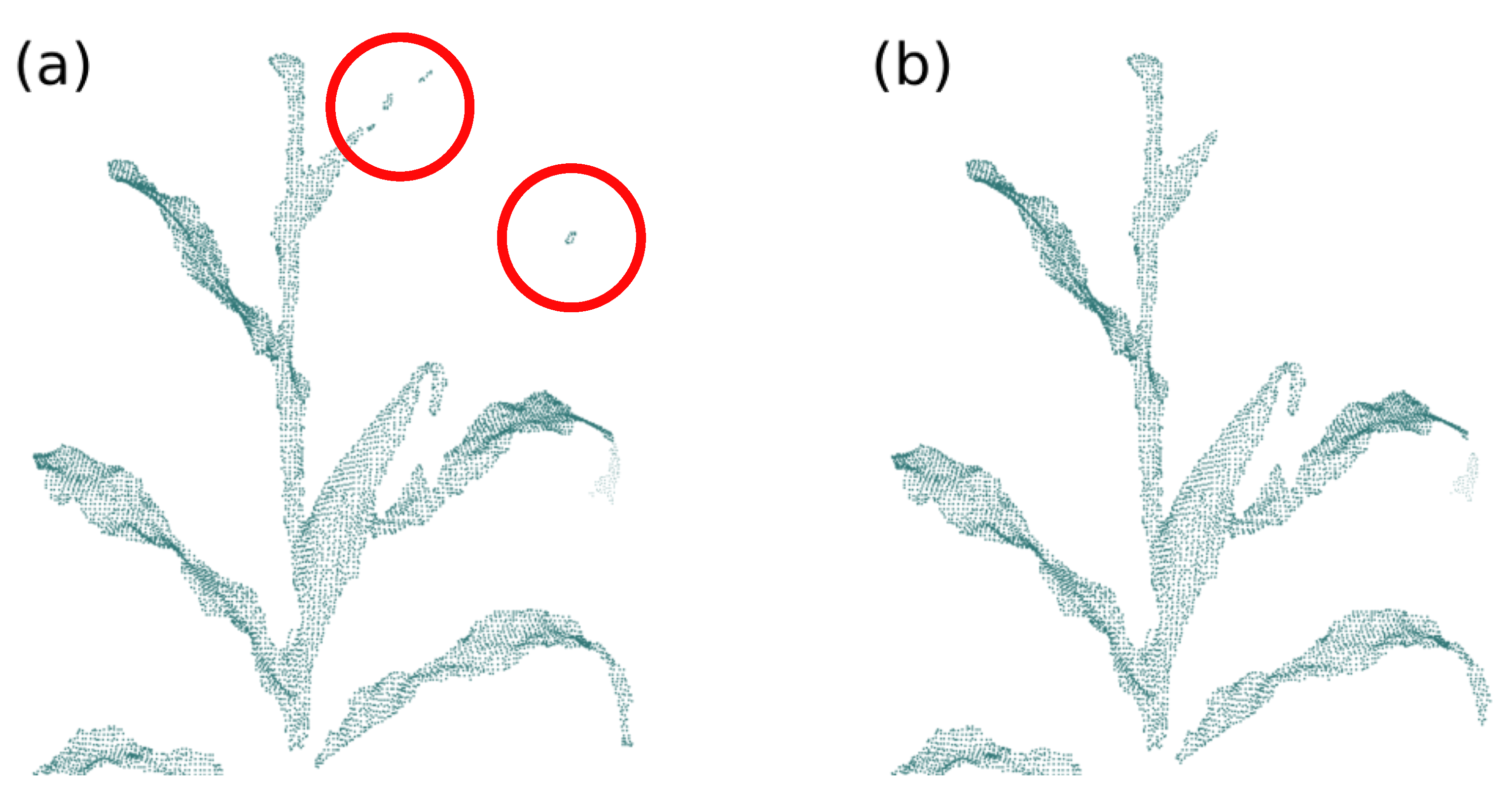
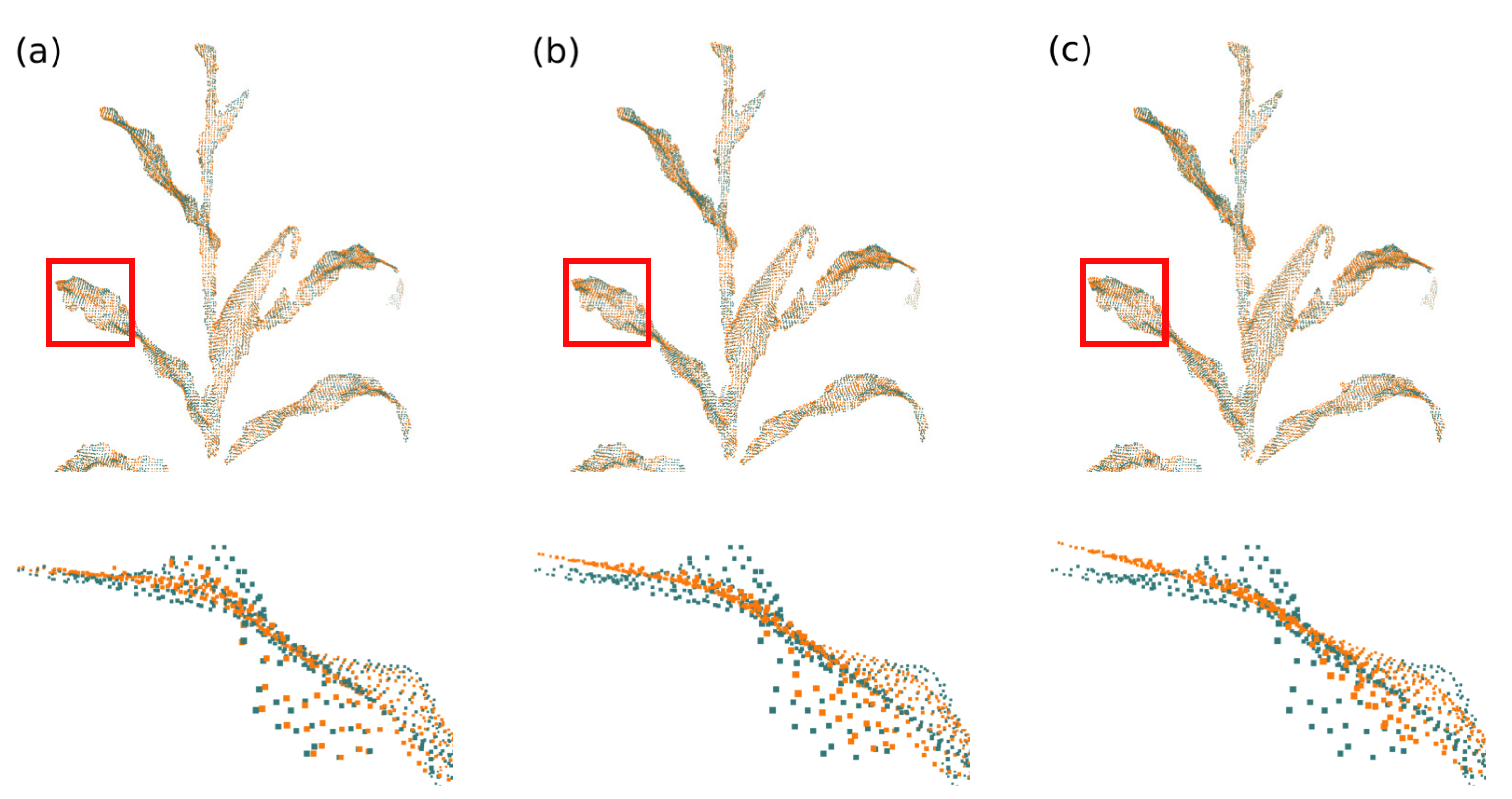
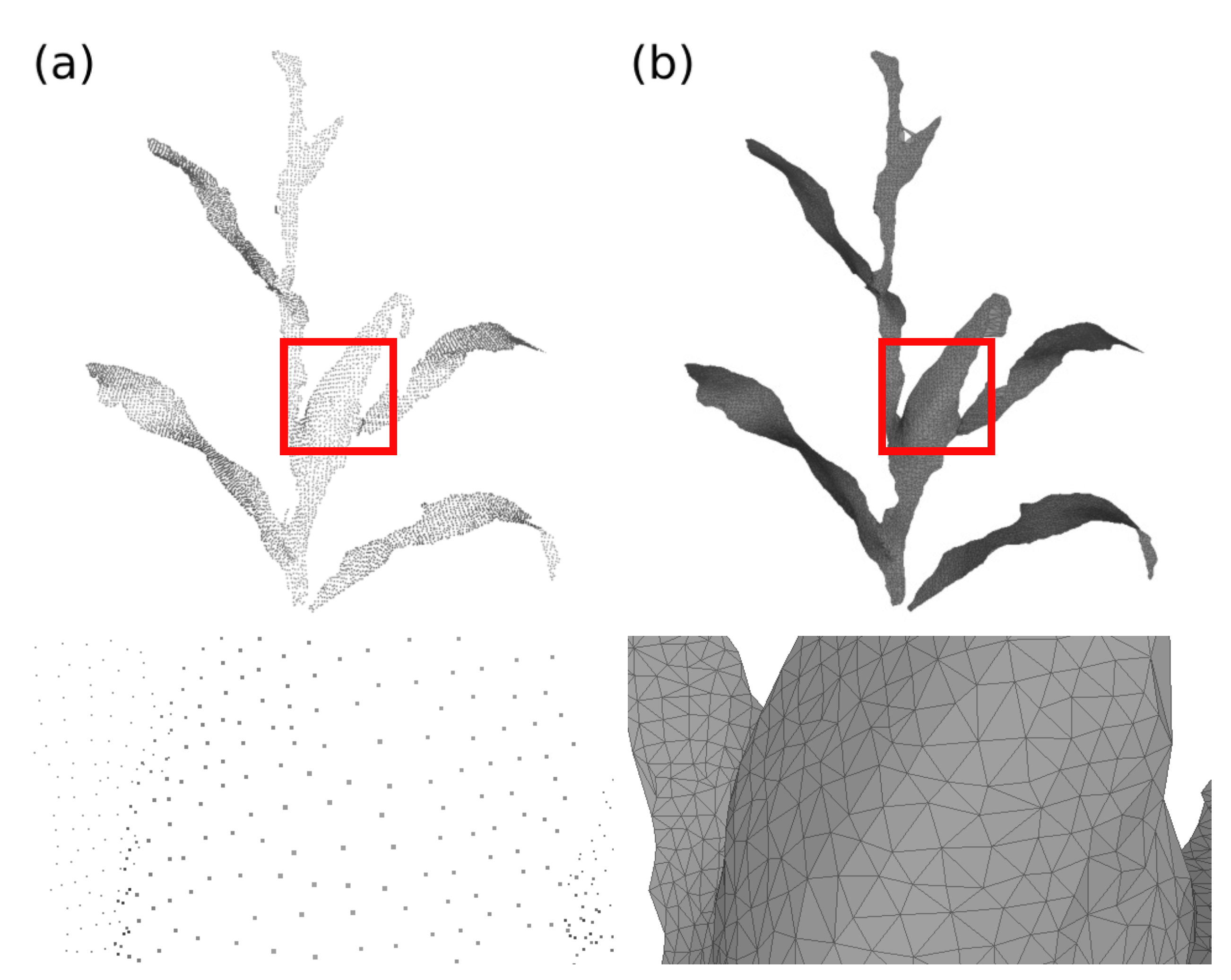

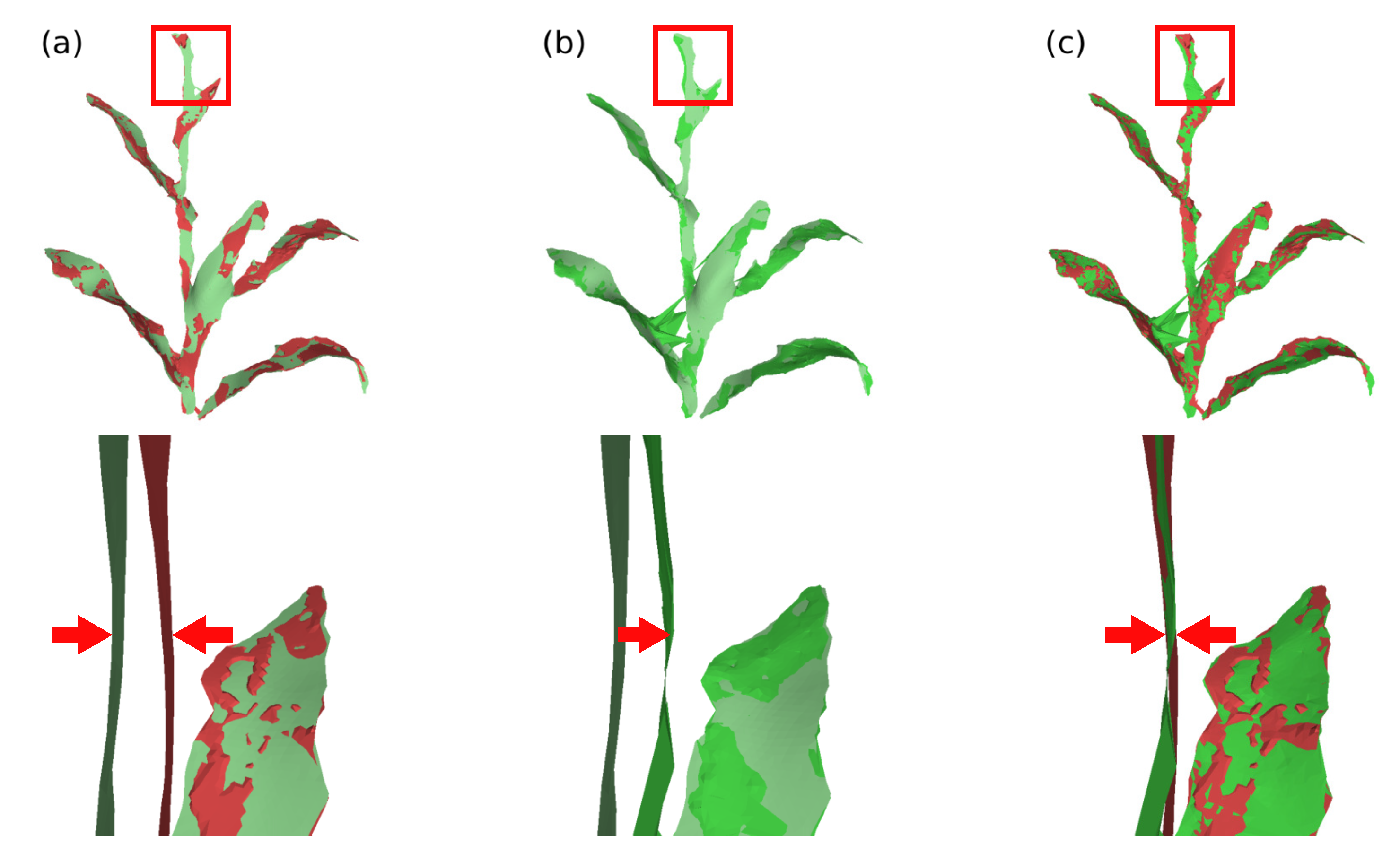
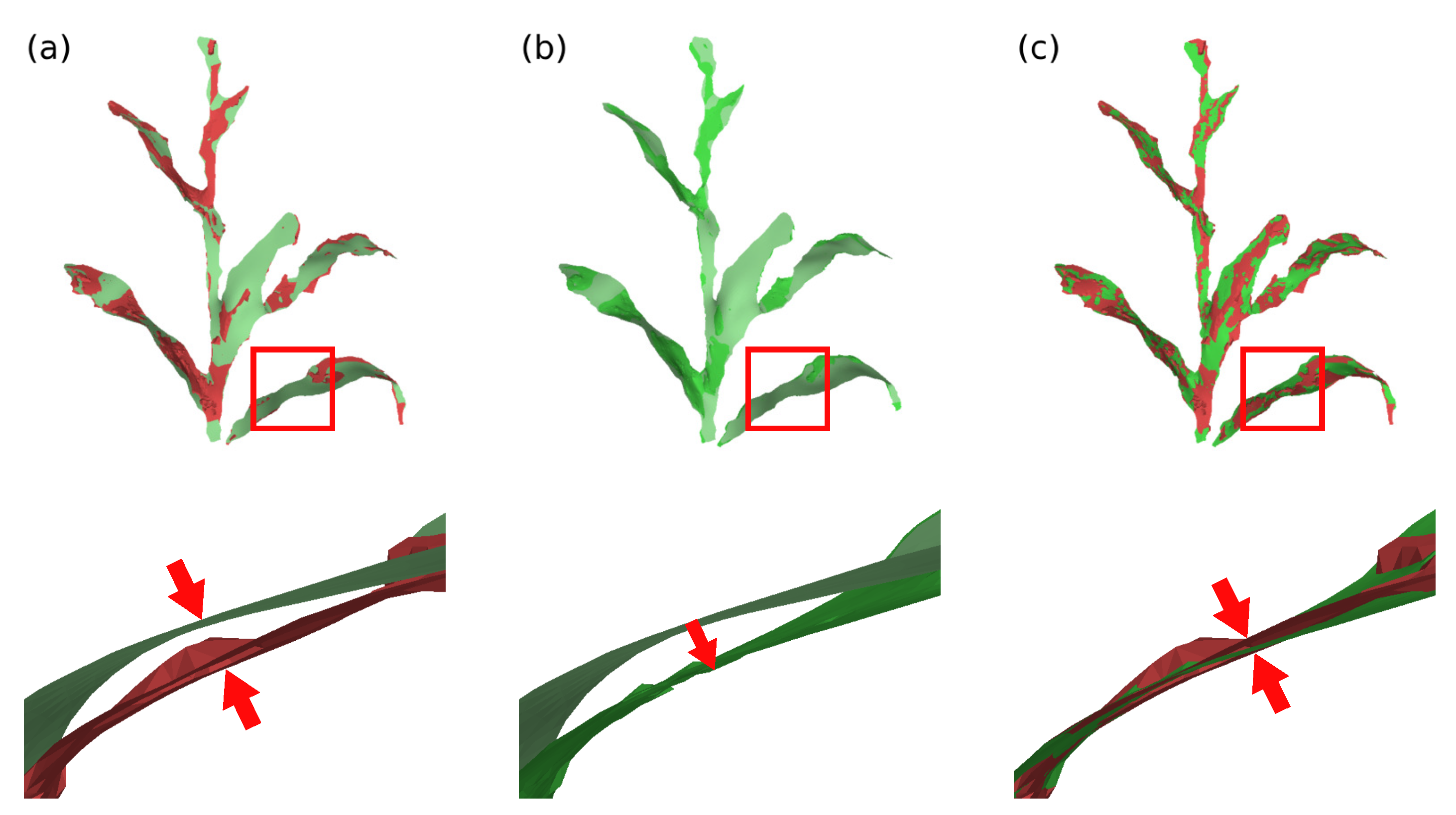

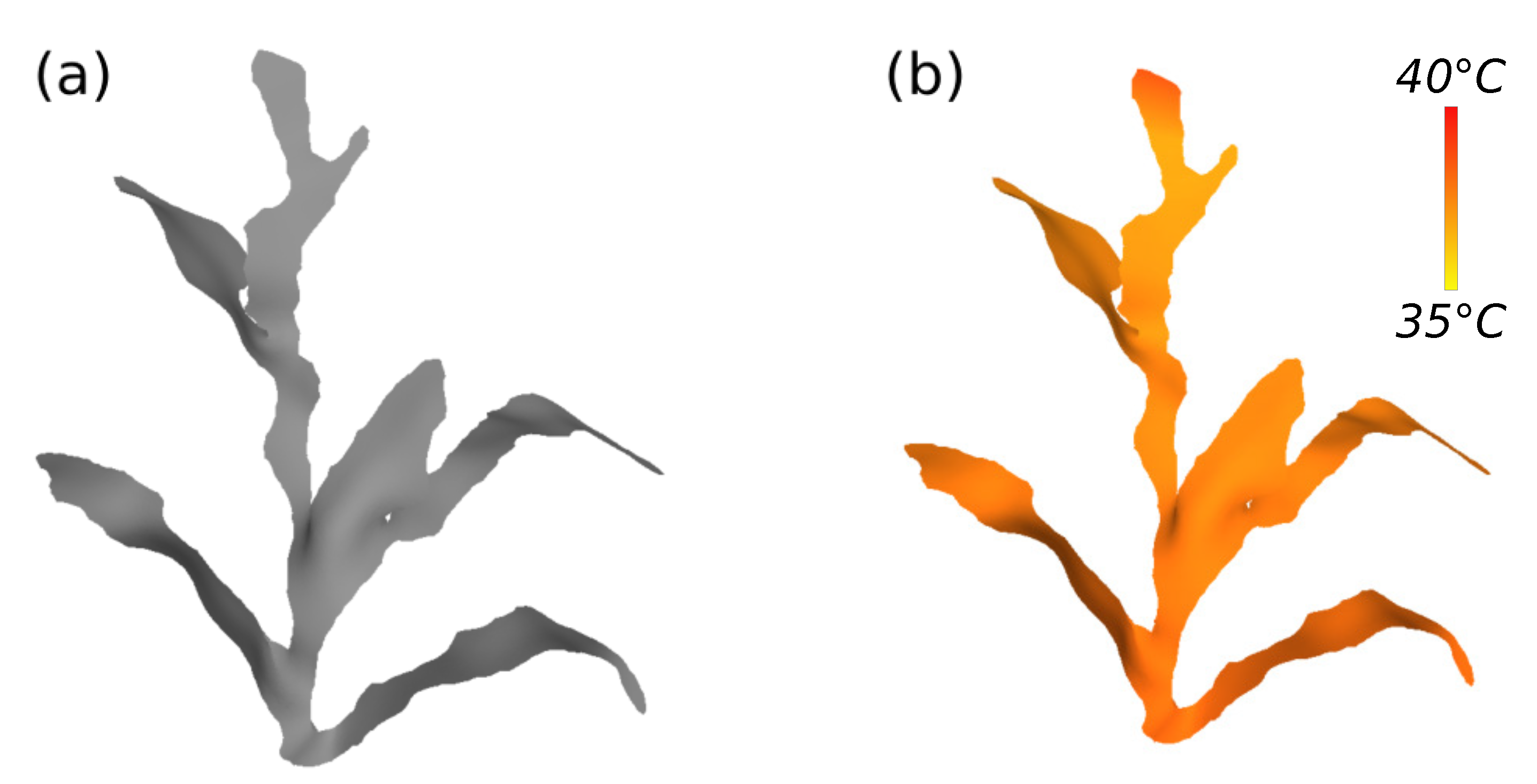
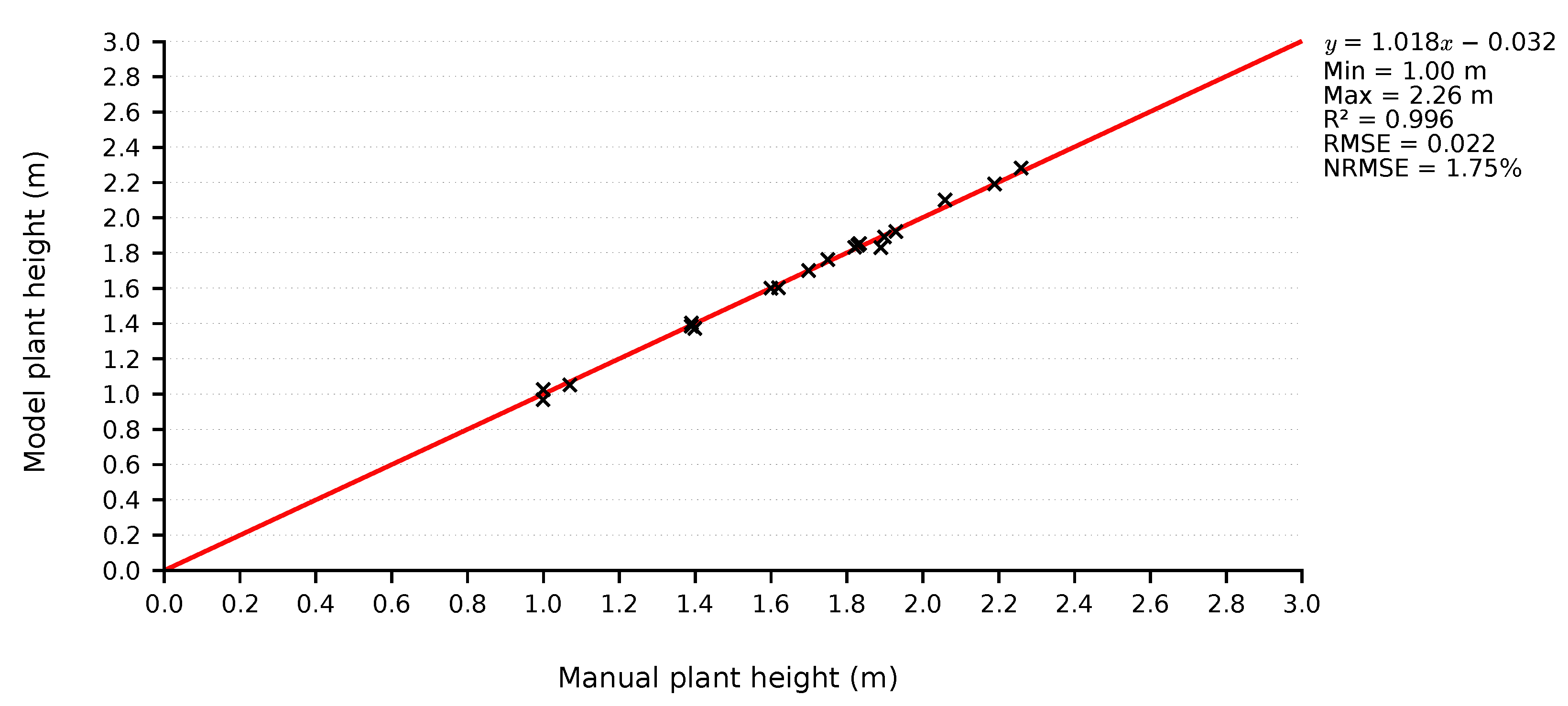

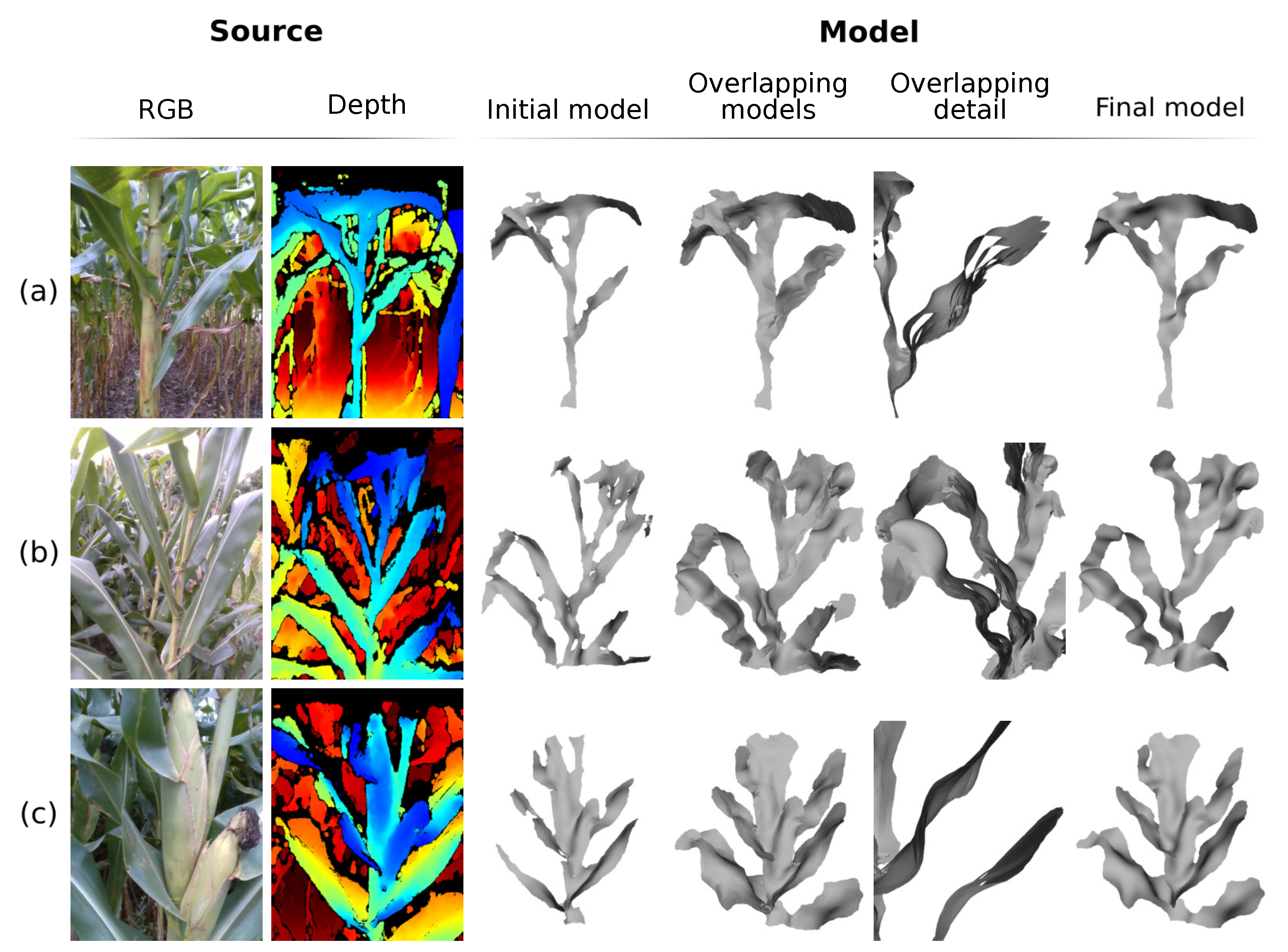
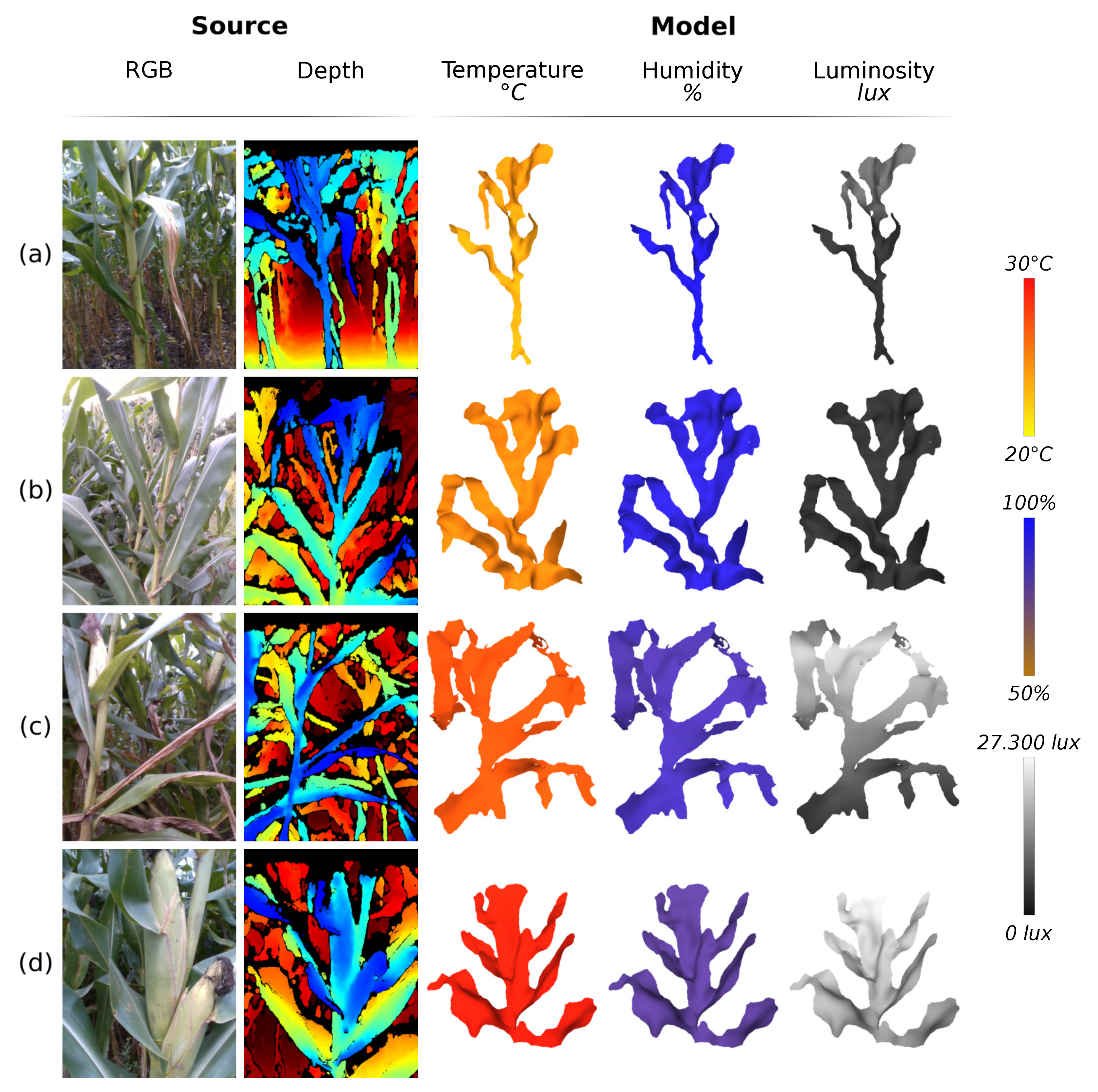
Publisher’s Note: MDPI stays neutral with regard to jurisdictional claims in published maps and institutional affiliations. |
© 2021 by the authors. Licensee MDPI, Basel, Switzerland. This article is an open access article distributed under the terms and conditions of the Creative Commons Attribution (CC BY) license (https://creativecommons.org/licenses/by/4.0/).
Share and Cite
Sampaio, G.S.; Silva, L.A.; Marengoni, M. 3D Reconstruction of Non-Rigid Plants and Sensor Data Fusion for Agriculture Phenotyping. Sensors 2021, 21, 4115. https://doi.org/10.3390/s21124115
Sampaio GS, Silva LA, Marengoni M. 3D Reconstruction of Non-Rigid Plants and Sensor Data Fusion for Agriculture Phenotyping. Sensors. 2021; 21(12):4115. https://doi.org/10.3390/s21124115
Chicago/Turabian StyleSampaio, Gustavo Scalabrini, Leandro A. Silva, and Maurício Marengoni. 2021. "3D Reconstruction of Non-Rigid Plants and Sensor Data Fusion for Agriculture Phenotyping" Sensors 21, no. 12: 4115. https://doi.org/10.3390/s21124115
APA StyleSampaio, G. S., Silva, L. A., & Marengoni, M. (2021). 3D Reconstruction of Non-Rigid Plants and Sensor Data Fusion for Agriculture Phenotyping. Sensors, 21(12), 4115. https://doi.org/10.3390/s21124115






